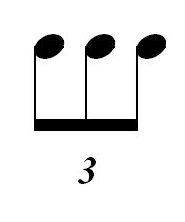This is a continuation of a lesson on staff music from a previous post.
Time Values
You likely already know that music has a beat. Most of us have tapped our feat or clapped along to a song. You have probably also already noticed that some beats are longer than others. Well, we have a hand little system to work out how those beats should go.
We'll start with a whole note. The whole note is just a circle on the staff that represents 4 beats.
Now, if we half that, it becomes a half note (see what we did there?). Half notes are the little circles but with a bar going straight up or straight down. They get 2 beats.
Now we get to the quarter note. A quarter is half of half and gets 1 beat. The symbol is the half note with the circle filled in (like a dot with a stick coming out of it).Next, is the eighth note. All we do is add a flag to the quarter and it becomes an eighth. If we have two or more of them next to each other, then we tie their flags together. They get half of 1 beat.
Next, is the sixteenth note. Add another flag, and they get one quarter of a beat. We can keep adding flags and keep going, but this is the gist.
Here is a basic break down of rhythm notes:
We can modify any of these in a couple of important ways. First is the "Dot". A Dot looks like, well, a dot added to the right of the note. It adds one half of the value of the note to its length. So, a dotted half, like our example here, would be 2 beats, plus 1 beat, equals 3 total beats.
Secondly, we can use a Tie. Ties combine notes together to make them longer or to show a more connected movement from one pitch to another (also know as a Slur). Sometimes, Ties are used to connected the same note from one side of a Bar to the other (see below). To get the time value, just add the values of each of the notes up.
Lastly, we have syncopation, also known as triplets. Most triplets will be in values of three such as 3, 6, 9, etc. Usually, you will only see triplets in 3s. But, any odd number can be used in syncopation. The basic format looks like this:
Lastly, there are specific symbols in rests that we use for each division of beat. Rather than go through them all again, here is the tree for their values:
Come back for the next section of music notation which deals with key signatures, time signatures, and repeats.









No comments:
Post a Comment